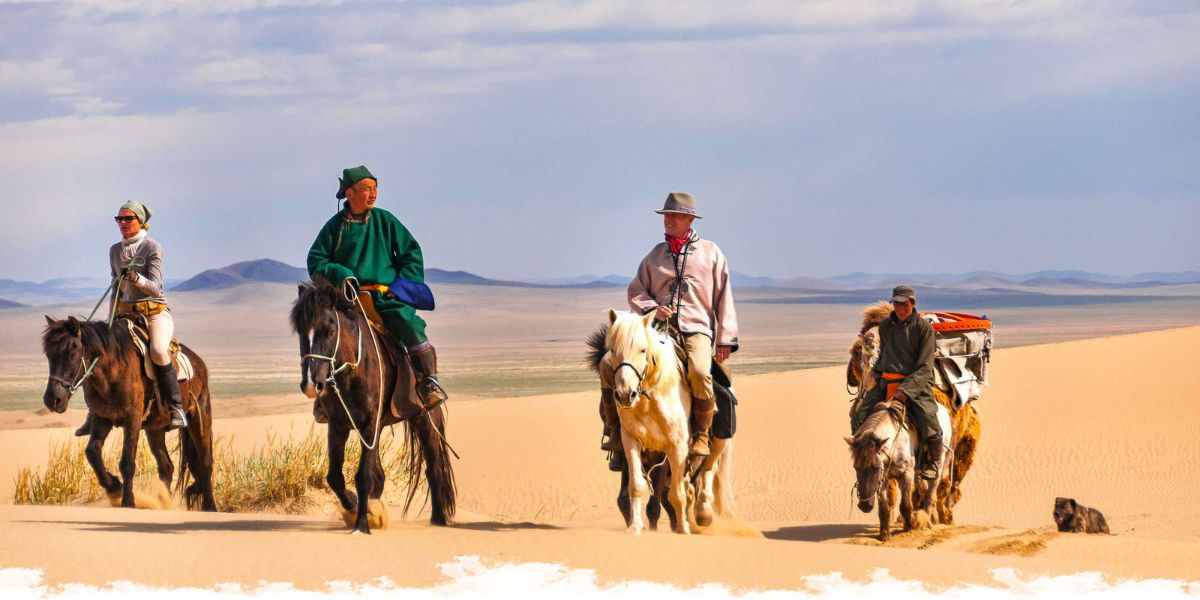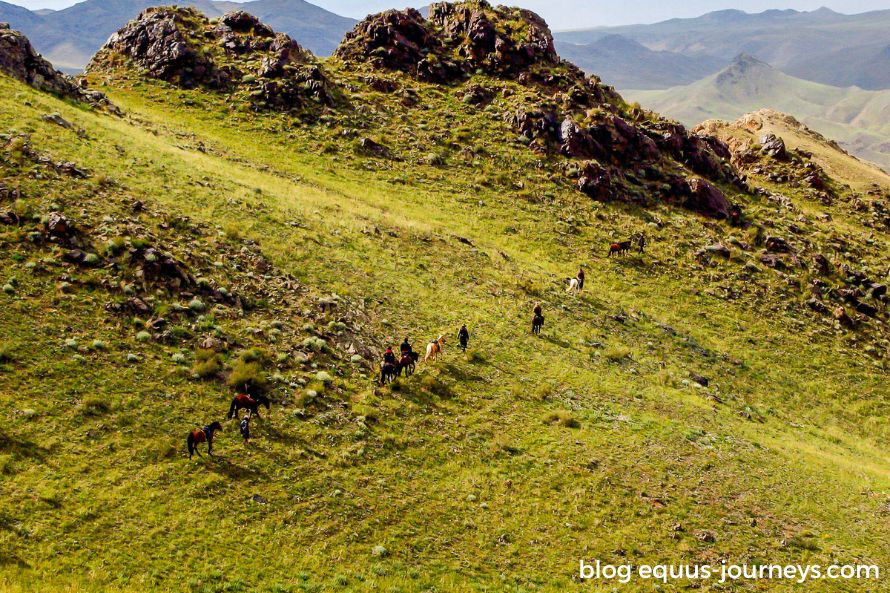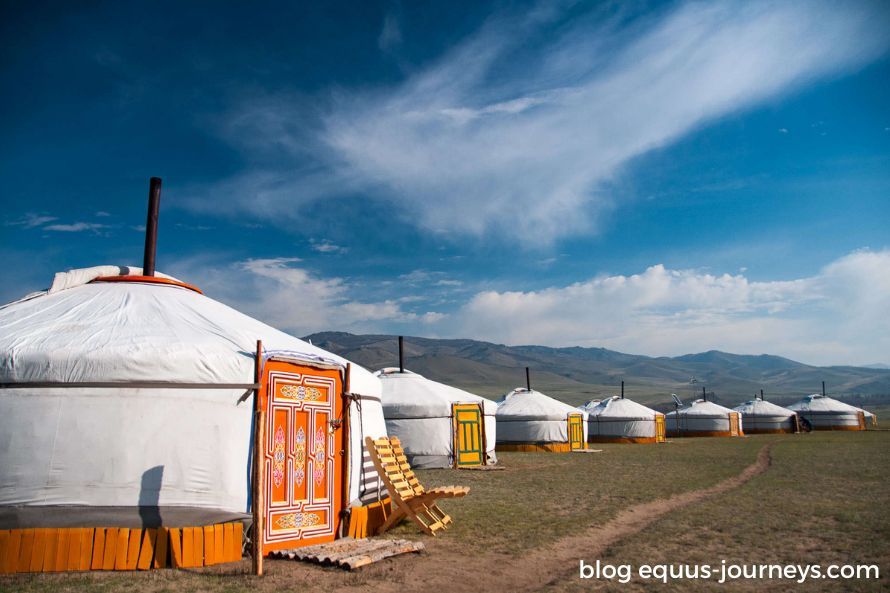
Riding Holiday in Mongolia: Everything You Need to Know
Mongolia, a country where past and present still coexist, offers a unique experience for equestrian travel. With a lifestyle still strongly influenced by nomadism and a strong horse culture, it's a top destination for many horseback adventurers.
Mongolia - What to expect?
Two very distinct ways of life remain in Mongolia: urban lifestyle and nomadism. Nearly half the population lives in the capital, Ulaanbaatar. Some live in smaller cities, but a significant portion of the population still lives the traditional, nomadic way. In fact, Mongolia is one of the last places on earth where nomadism thrives.
If you’re seeking luxury hotels and gourmet dining, Mongolia may not be for you. Communication often requires an interpreter and travelling through Mongolia means exploring vast natural landscapes with limited infrastructure, mostly accessible by jeep, (or by horse!) But rest assured, a trip to Mongolia is a very special experience for many intrepid explorers. Here's what you need to know:
Riding Holiday Options
Mongolia is the cradle of equestrianism in Asia and is an excellent choice for an adventurous trail riding holiday. This is a big country with distinctive provinces and as such, every trip is different. However, they all have two very important features in common: the Mongolian horse and the fantastic hospitality of the Mongol people.
- For a first taste of what Mongolia has to offer and for those who enjoy a variety of activities, you could choose our Hiking & Horse Riding trail, designed for novice and intermediate riders. Guests sleep in yurts both at family camps (traditional/basic) and at tourist camps (more facilities), so you can expect a little comfort as well as some adventure along the way.
- Experienced riders with an adventurous streak might consider Across the Orkhon Valley, where you stay mostly with local families and enjoy long days in the saddle.
- These same riders could also take a look at our longer ride and camping trail across the Zavkhan region in the west, where you'll camp in tents for much of the trail.
- For those seeking consistent comfort, you may enjoy our Riding and Yurts holiday, which explores the southern fringes of the Khan Khentii. Most nights are spent at a mobile camp, transported by a caravan of yaks, which includes dining and bathroom tents. You will also be provided with bed linen.

The Mongolian Horse
The Mongolian horse is a central part of Mongolian culture and history. These small, sturdy horses are renowned for their endurance, resilience and ability to thrive in the harsh conditions of the Mongolian steppe. They may be small, but they are strong! These horses are also integral to traditional Mongolian festivals and sports, particularly in the famous Naadam festival (held in July), where they compete in games and races. Their spirited nature and significant cultural heritage makes them a symbol of Mongolia's nomadic lifestyle.
Riding style, gear and handling the horses
The riding in Mongolia is different from English riding. You may be asked to mount from the left, and you may ride with one hand, so it's good to be adaptable and open-minded. On your holiday in Mongolia you may hear your guides use a verbal command that sounds a little bit like “Choo-Choo” when they want their horse to go faster. The pace is usually active with lots of trots, some long canters and sometimes gallops. You need to keep a close eye on the ground as there can be holes.
You ride in Kazakh and Russian saddles. The
stirrup leathers are adjustable, but riders who are very tall may find
that they are short in length and could consider taking their own pair of
stirrup leathers. Saddle
comfort varies, so you might also want to take a seat saver (small sheepskin or pad) that you can tie to the saddle with strings. Please don’t bring anything
precious or valuable, and ensure it can be attached securely to the
saddle (your guides will do this for you). Alternatively, you could
consider bringing padded shorts. Stirrups
are often made from knotted fabric— please wear chaps to protect your calves. If
something about your saddle is uncomfortable, please speak up at the start of
the ride —the team will do their best to help.
Mongolian horses are considered semi-wild. Most of the herd isn’t ridden or handled much throughout the year, and only geldings are ridden generally. The horses are thought of as working animals, not pets,
and they aren’t used to affection like horses in Western cultures. Riders
should be prepared for a range of temperaments and to accept that
Mongolians relate to their horses in a different way. The
horses may also be a little nervous at times and react to flapping raincoats or noisy ponchos, so riders should avoid wearing clothing that flaps around and makes a noise (and please don’t remove or add clothing when on your horse). Your guides will probably hold your horse while you
mount or dismount, and they will saddle the horse for you – please don’t be
offended, this is for your own safety. You are welcome to lend a
hand with things like watering the horses in the evening and helping the guides
in the morning. Please follow the advice of your guide and ask for their help
if you’re unsure.
Accommodation
- In Ulaanbaatar: Standard 3-star hotels (usually twin, double or triple rooms) with an ensuite bathroom and wifi.
- Tourist Camps: Open from mid-June to mid-October, these camps consist of several yurts with separate buildings for restrooms and dining. Electricity, toilets, showers and hot water are usually available (though hot water may be inconsistent). A yurt can typically accommodate 2 - 5 people.
- With Nomadic Families: You will be accommodated in yurts set up next to the family yurt, which can usually accommodate 2 - 5 people. Compost toilets in a wooden cabin (or sometimes holes in the ground) are located near the camp. Mongolian beds are short and the mattresses thin. You will need a sleeping bag (usually available to rent) and a camping pillow. Most families don't offer showers but on some rides, there may be a portable shower set up for you. You may also like to bathe in nearby lakes and rivers.
- Camping: Tents are provided for the Zavkhan ride, with meals prepared by your guide or cook. You will need a sleeping bag and a camping pillow.

Travelling in Mongolia
Mongolia has few paved roads,
totalling just 3,000 kilometres, mostly around Ulaanbaatar. These roads are
often poorly maintained. Many routes are gravel tracks or simple paths through
the steppe, requiring robust 4x4 vehicles. Road conditions also vary with the
weather. On your trip, please be prepared for a bumpy, and
sometimes long transfer from the city into the steppe. You may want
to download podcasts or audiobooks on your phone for long road trips.
Money
The local currency is the
tugrik. You can bring cash (Euros or US dollars are most accepted, others are rare)
and exchange it locally. Please note: it is best to exchange money in the city
(not at the airport) for a better exchange rate. Your guide can recommend the
best place to do this. You can also withdraw money from an ATM in the city. Please remember to bring some cash for purchases along the ride (budget approx. €60-€80) and additional cash for tips. You
may also want cash for shopping in Ulaanbaatar (credit cards may be accepted in
bigger shops or for large purchases).
Devices and communication
You can use a Type C
(Europlug) in Mongolia (please bring USB cables and adapters). The tourist camp
may provide 220V electricity and some nomadic families may have solar panels,
but power is limited. We would recommend charging your
devices via the vehicle’s cigarette lighter, and bringing a solar charger and/or good power bank. A cost-effective way of
contacting family back home is to buy a local SIM card, which you can do upon
arrival in Mongolia. Approx. €10-€15 should give you 3GB - 5GB of internet. We
recommend that you buy a SIM card from Mobicom. Please note: There may be some
phone coverage on rides, but not always. Be prepared to disconnect and enjoy
time without your phones and devices.
Food
Mongolian food is simple and
meat-based. Dumplings and fried pastries are also Mongolian favourites. There
are also plenty of cheese and dairy products made from yak, cow, goat or mare.
Milk tea is the most common mealtime drink, but you’ll also have the option of
drinking water, often served warm. Vegetables are mostly root
vegetables like potatoes, carrots, cabbage and onions. Breakfasts include bread, butter, jam, tea or coffee, sometimes eggs, and dairy products. Vegetarians and vegans can usually be accommodated if you tell us in advance, but please note, if you're planning to stay with local families, we can't guarantee that the food won't have traces of meat and dairy in it, or have been cooked in the same pot / with the same sauce. Water: Please do not drink
from unknown sources. You will be supplied with fresh water to drink. You may
also bring water-purification tablets such as Micropur or a small water filter.
Tip: Your digestive
system may not be used to the different food and drink in Mongolia. If you have a sensitive stomach, you could consider taking a
course of probiotics before and during the trip to help your digestive system
adjust. You can ask your doctor or pharmacist for advice.
Climate
Mongolia has a continental climate with extreme conditions. It has an average altitude of about 1,500 meters, with many peaks above 4,000 meters. It enjoys 280 days of sunshine annually, earning it the nickname "Land of the Eternal Blue Sky." The best months to visit are from June to September, with temperatures exceeding 20°C from June. The steppe turns green in July and remains so for about two months. Nights get colder from mid-August, with daytime temperatures hovering between 15-25°C until mid-September. When
packing, please be prepared for hot and cold temperatures, as the weather can
be changeable and unpredictable. Summer is
also the rainy season, so rain protection is
crucial.
Gifts for families
Mongolian tradition wants the traveller to thank his host for his kind hospitality by offering small gifts. This tradition does not mean that these nomadic families cannot meet their primary needs. Nomads, despite their isolation, are fully integrated into contemporary society. Their livestock activities bring them a small income that sometimes is not enough to finance their children's education or the maintenance of the yurts. Therefore, avoid offering soaps, pens, or used clothes, which often make these families uncomfortable. Alternatively, you might consider fresh vegetables and fruits (to be bought on the way), cakes or sweets (which are popular), specialties from your home, toys or books for children, kitchen utensils or camping accessories. You can also simply contribute with a small financial support which may better meet the real needs of these families.
Cultural Etiquette
Mongols are naturally shy: as tradition dictates, they rarely show their emotions. But do not hesitate to approach and engage with the local people. Feel free to take initiatives even if interpreters are not by your side. Do not be disappointed to see your host put aside the gift you offer them. As the Mongolian proverb says, "Don’t look a gift horse in the mouth”!
You may have heard of many traditions and rituals to follow when visiting nomads. Do not worry; they will forgive your small mistakes. However, some rituals and rules should be known and respected to avoid offending your hosts:
- Refusing a drink can be poorly received; at least touch it to your lips before passing it on, or set it down if there’s one glass per person.
- When handed a bowl or plate with dried cheese or other items, it’s customary to touch the bottom of the container before serving yourself—this is a sign of respect.
- Inside a ger (the real Mongolian name for what we call a 'yurt'), watch your head — the doorway is low. You should move clockwise inside and avoid walking between the central posts.
- The hearth in the center of the yurt is sacred: do not throw anything in it (especially not your dirty tissues!) and do not pass between the two poles.
- The basins used for cooking are different from those used for washing clothes: if you want to wash some clothes, ask your host for the right basin.
- The gesture of putting your thumb between the index and middle finger while making a fist is equivalent to the middle finger in Europe and should be avoided.
- The northern part (the back) of the yurt is reserved for the head of the family; do not go there unless invited. Once familiar with the family, you can go there.
- In temples or places of worship, remove your hat or cap. Taking photos is not always allowed.

Packing and logistics
When packing for Mongolia, please remember
that the region can be cold and it would be wise to bring layers! You should also make sure to pack any
essentials in your hand luggage - this includes your sleeping bag, towel and
sanitary products (within allowance), rain jacket and your riding gear -- just in
case your luggage is delayed. Please do not bring suitcases
– instead, bring a soft-sided bag which is more easily transported/packed.
On some rides, your luggage will be
transported by a support vehicle, but there may be days when the vehicle can't follow, and you will
need to travel light – in this situation you can transfer some of your essential belongings into a
smaller bag that can be taken with you on pack horses or yaks (you can leave your big bag
with the host family or the support vehicle and collect it later). For the Zavkhan ride, you will also need to travel light as you'll take a domestic flight with a limit of 15kg for checked luggage and 5kg for hand luggage.
Final tips
- Mongolia is a safe country, but caution is still advised, especially in Ulaanbaatar: keep an eye on your personal belongings in tourist spots. In the countryside, remember to note where you leave your belongings.
- Please take your rubbish home with you. There are no recycling facilities in Mongolia, so take your used batteries, aerosols etc. back home and dispose of them appropriately. Try to leave excess packaging material at home before travelling.
- Visiting a new country offers the opportunity to meet other cultures with different mentalities, therefore it is important to accept these differences and respect the local way of life. Be prepared for time perception differences: Nomads don’t wear watches: time is fluid and punctuality isn’t a priority. Guides will adhere to schedules, but nomadic families may not. It’s good to be flexible.
- Please remember that Mongolia is full of surprises: You may experience things like detours and schedule changes. The people looking after you will do their best to handle any unforeseen events and to give you an exceptional experience, but it is helpful to let go of strict planning and to embrace the spontaneity.
More information...
We hope that this guide to riding holidays in Mongolia is useful – whether you have already booked your trip or are just “browsing” for now! Mongolia is an unforgettable adventure, and we look forward to hosting you on one of our rides. If you have any questions, please contact an Equus Journeys travel consultant at info@equus-journeys.com or give us a call on +44 1905 388 977.
